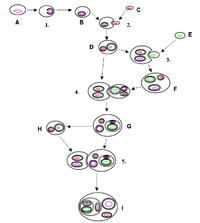
Photo from wikipedia
This study sheds light on a poorly understood area in insect–plant–microbe interactions, focusing on aphid probing and feeding behavior on plants with varying levels of arbuscular mycorrhizal (AM) fungus root… Click to show full abstract
This study sheds light on a poorly understood area in insect–plant–microbe interactions, focusing on aphid probing and feeding behavior on plants with varying levels of arbuscular mycorrhizal (AM) fungus root colonization. It investigates a commonly occurring interaction of three species: pea aphid Acyrthosiphon pisum, barrel medic Medicago truncatula, and the AM fungus Rhizophagus irregularis, examining whether aphid‐feeding behavior changes when insects feed on plants at different levels of AM fungus colonization (42% and 84% root length colonized). Aphid probing and feeding behavior was monitored throughout 8 h of recording using the electrical penetration graph (EPG) technique, also, foliar nutrient content and plant growth were measured. Summarizing, aphids took longer to reach their 1st sustained phloem ingestion on the 84% AM plants than on the 42% AM plants or on controls. Less aphids showed phloem ingestion on the 84% AM plants relative to the 42% AM plants. Shoots of the 84% AM plants had higher percent carbon (43.7%) relative to controls (40.5%), and the 84% AM plants had reduced percent nitrogen (5.3%) relative to the 42% AM plants (6%). In conclusion, EPG and foliar nutrient data support the hypothesis that modifications in plant anatomy (e.g., thicker leaves), and poor food quality (reduced nitrogen) in the 84% AM plants contribute to reduced aphid success in locating phloem and ultimately to differences in phloem sap ingestion. This work suggests that M. truncatula plants benefit from AM symbiosis not only because of increased nutrient uptake but also because of reduced susceptibility to aphids.
Journal Title: Insect Science
Year Published: 2018
Link to full text (if available)
Share on Social Media: Sign Up to like & get
recommendations!